Red Rock 'n Roll: How to Pull Off the Perfect Utah National Parks Road Trip
As the morning’s first rays beam through windows encasing my comfy bed in an Adventure Wagon Sprinter 144 van, the feeling hits me again. Parked on the edge of Grand Staircase-Escalante National Monument—on a Utah national parks road trip—we've arrived in our personal oasis. The van’s cool air, a stark contrast to the bone dry heat already warming this rocky, desolate landscape in the heart of Southwest Utah, makes me want to hunker down in our little Sprinter sanctuary, but only for a few extra moments. Soon enough, we’re naturally drawn out into yet another spectacular scene during our week-long Utah national parks road trip.
Related: These Lesser-Known Scenic Drives Roll You Way Beyond the Crowds
Sliding open the van’s door, I emerge into a massive amphitheater perched above sandstone cliffs dropping into a twisty brown river. Steaming French press coffee awaits on a sleek wooden Dometic table overlooking the desert vista. It’s a breakfast vista that conjures comparisons to Horseshoe Bend, which is not far from here, and even the Grand Canyon to a degree.
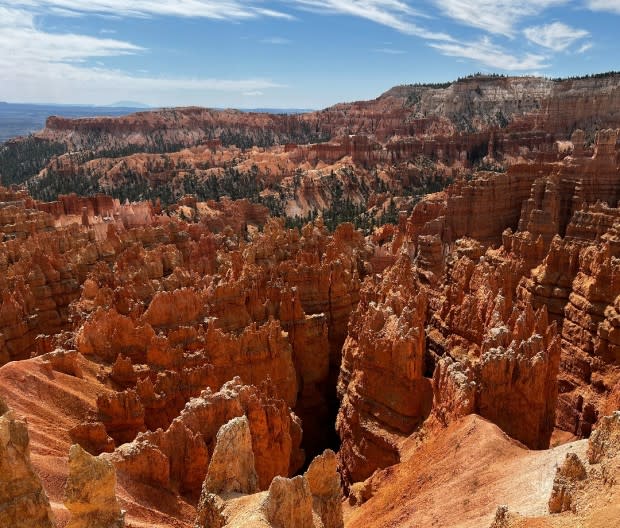
David Young
From Moab to Grand Staircase-Escalante, Bryce Canyon National Park, and Capitol Reef, here remains one of the more rugged and remote regions left in the old American Southwest. It’s reminiscent of classic road trip scenes described in Edward Abbey’s Desert Solitude and Kerouac’s On The Road, which described this part of the country as a “road to heaven.” Indeed, it’s a place where you can insert many a mile and acre between you and anywhere else. Southern Utah is still one of the best places on Earth to just disappear for awhile, in the best sense. Here’s how we pulled off a fantastic week-long Utah parks road trip from Denver to Grand Staircase-Escalante National Monument in the perfect vehicle with spectacular stops along the way.
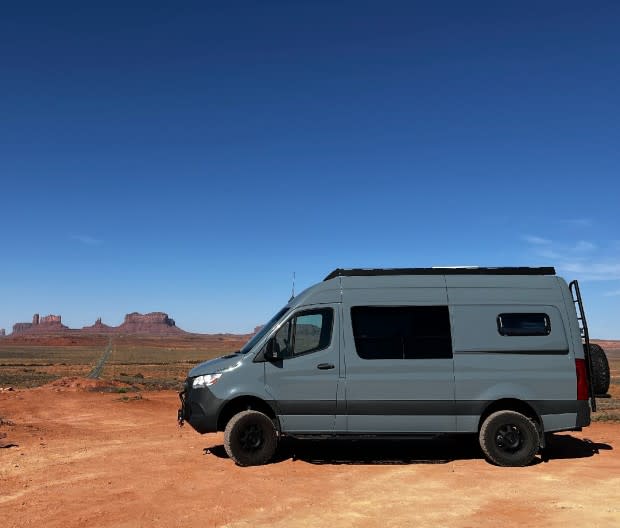
David Young
How to Choose the Right Vehicle for a Utah National Parks Road Trip
When it comes to a road trip in these parts, the vehicle is everything. It’s more than just your mode of conveyance. It’s where you spend much of your days, and it can make or break a trip accordingly. The mix of comfort and reliability all in one vehicle is key.
Thankfully, the days of the family Griswold station wagon are long gone. Today, when it comes to cross-country trips, the van life movement has revolutionized road travel. These large vans are outfitted with everything from plush beds to kitchen sinks, making your home for the night wherever you decide to park.
Related: Complete Guide to Zion National Park: Hikes, Hotels, and Tips
For our cross-country trip, we opted for an Adventure Wagon, made by a company which specializes in modular van setups to accommodate a variety of adventures and lifestyles. More than just a barebones “home on the road,” it’s an all-purpose home base for mobile adventures.
The modularity of the Adventure Wagon's system allows users to configure seating, sleeping, and storage based on their activity in a matter of minutes. Our van setup includes a bed, a pullout tray bike rack, and a galley with sink, stove, and fridge. Add plenty of ingeniously placed storage room for gear, bags, and a pile of firewood, and you’re fully equipped and prepared for wherever the road takes you.
Day 1: Denver to Rabbit Valley, CO
We hit the highway with the Utah/Colorado border in mind for our first stop. On a holiday weekend in late spring, the majority of campgrounds and dispersed camping between the Front Range and the Western Slope of Colorado are unsurprisingly packed. Rolling onwards under a crystal clear Milky Way lighting up the cool desert evening, we park the large yet maneuverable Sprinter in Mesa County’s Rabbit Valley region—swiftly shifting from driver’s seat to bed without leaving the vehicle.
As the name implies, Rabbit Valley is a valley located in northwestern Mesa County best known for its mountain biking and OHV trails. Located within McInnis Canyons National Conservation Area, there are five established campgrounds available for camping with easy access to trails in the area. I rode my bike right out of camp hitting Trails 2 and 3, which provide stellar views of the surrounding region including the Colorado River and La Sal Mountains.
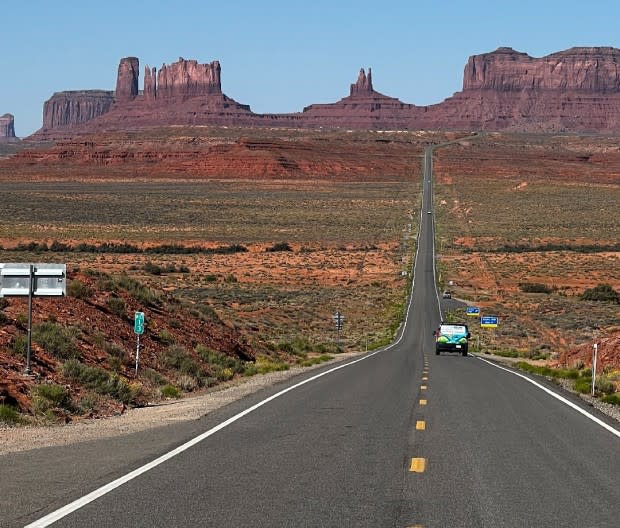
David Young
Day 2: Moab, Monument Valley, and Goosenecks State Park
After some crisp morning mountain biking the next day we press on toward Utah, finding ourselves driving through Castle Valley and Moab. Other vanlifers wave as we pass. Officially in the club, we wind along the swollen chocolate milk-hued banks of the Colorado River, churning its way through the red rocks surrounding Moab. The town and area surrounding Moab is best known as a mountain biking mecca, featuring famed trails such as Slickrock and The Whole Enchilada. Located in eastern Utah, it also serves as the gateway to Arches National Park, Dead Horse Point State Park, and Canyonlands National Park. Each of these special places is worth its own trip, offering otherworldly desert vistas and landscapes.
Soon, we’re ensconced in iconic Monument Valley Navajo Park, forever immortalized in Forrest Gump and numerous old Westerns. This majestic landscape is on the Arizona and Utah border and is literally right out of a John Wayne classic (The Searchers). The red sand desert’s flat valley gives way to a geological masterpiece as sandstone buttes and towers reaching 1,000 feet jet out of the dirt. The drive through this landscape is about 17 miles and may take an hour with all the photo opportunities along the way.
Pulling into Goosenecks State Park just before sunset, we enjoy a night in this convenient state park tucked away in Mexican Hat, UT, with desert scenery that foreshadows what’s to come. A campsite here will set you back just $10 and comes with a fire pit and solid park amenities. Some sites offer sun shades with relief from the harsh Utah rays, as there are no trees to be seen here. The main attraction at Goosenecks is the view. While there’s no access to the river below, you can take a great walk along the cliffside filled with panoramic views below and dark, starry-strewn skies above.
We park near a span of cliff overlooking the San Juan River as it snakes its way through the canyon. The massive vista reveals rock that has eroded for an estimated 300 million years, according to geologists. Every bit as magnificent as the canyon below are the countless constellations flickering above the chasm. We sit by the crackling fire sipping Smokewagon Small Batch Bourbon while watching rafters navigate the river by headlamps to their camp far below.
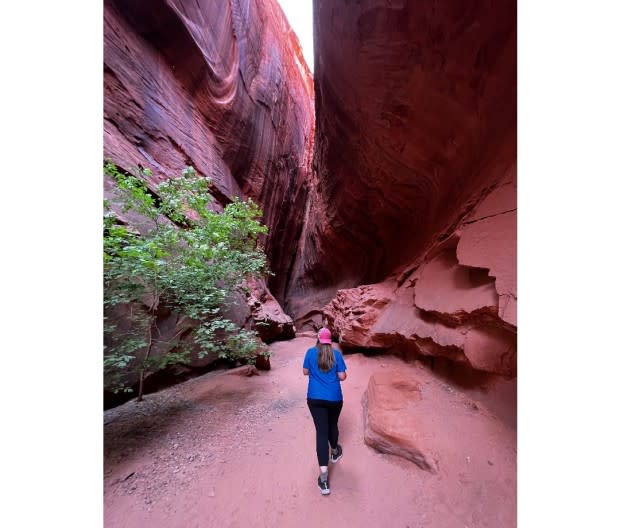
David Young
Days 3 to 5: Entering and Exploring Grand Staircase-Escalante National Monument
By day three of the trip, we’ve reached our final destination. Grand Staircase-Escalante National Monument is so massive that we’ll be driving around and through it for the next four days. Located in Southern Utah, Grand Staircase-Escalante is ideal for desert hiking, biking, canyoneering, off-roading, and camping.
Three distinct areas make up the monument: Escalante Canyons, Grand Staircase, and the 1,600-square-mile Kaiparowits Plateau situated between the two. In all, the region covers 1.7 million acres of slot canyons, arches, slick rock, hoodoos (eroded red and white columns of rock that branch into the sky), and even massive waterfalls. The otherworldly landscape spans sedimentary rock and fossil records covering 30 million years.
Traversing the area clockwise in the Adventure Wagon, we inch as close to the massive rock monoliths as the road will allow. The monument is so big we even dip into Arizona at one point, traveling through Page—home to Coyote Buttes and The Wave, Horseshoe Bend, and Antelope Canyon. Looping past the Pink Sand Dunes, we head north toward Bryce Canyon National Park, celebrating its 100th anniversary this year. The remote area is home to the largest concentration of hoodoos on the planet, offering breathtaking views of the 8,000-foot Paunsagunt Plateau.
Related: Lesser-Known National Parks, Forests, and Wilderness Areas
Soon, we’ll be deep in these clefts, hiking through canyons filled with vivid red and yellow cactus flowers to Lower Calf Creek Falls. We’ll swim in the frigid cold water as a massive waterfall spills over the slick rock above us. A relatively easy six-mile, out-and-back hike will offer more spectacular views of surrounding canyons and jagged cliffs. We’ll also venture out to Zebra Slot Canyon, filled with water from recent spring rains. The unique cream-colored striations on the sandstone impart a zebra-like quality to the spectacular canyon, while the rocks reflect a stunning mirror image in the water.
After living out of a van for the better part of a week, we’re more than ready for a shower and a bigger bed. The nearby towns of Bryce, Escalante, and Boulder can accommodate travelers in the area. We opt for a unique desert retreat that just opened called Yonder Escalante, tucked within Grand Staircase-Escalante National Monument on the grounds of an old drive-in movie theater.
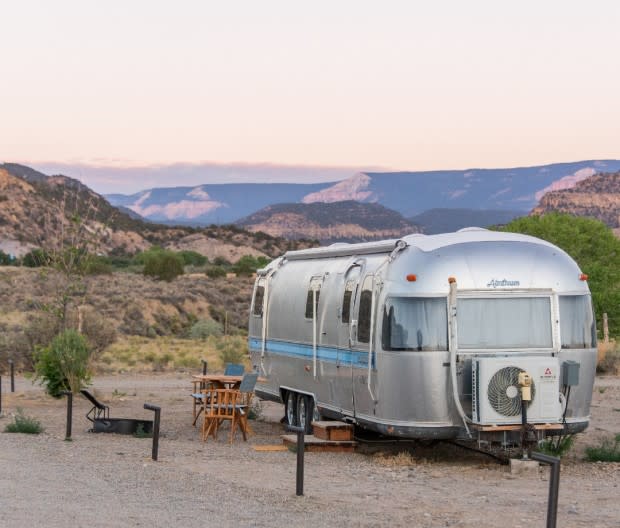
The Nomadic People
Days 6 & 7: Discovering Yonder Escalante—a Slice of Modern Luxury in the Western Desert
A former RV campsite, Yonder Escalante launched three years ago with the spirit of the American road trip at its core as a stylish lodging and camp spot. Yonder offers food, drinks, bathhouses, pool, hot tub, laundry and is pet friendly. Visitors can relax by the fire with majestic views of Southern Utah in every direction.
Yonder Escalante can be uniquely summed up as an adventure campsite melded with a luxury hotel in one of the most dramatic outbacks of the American Southwest. The juxtaposition of luxury and wilderness is so seamlessly meshed together here, it appears like a mirage as we pull through the gates. Paying close attention to detail and intimate connection to nature, the property lets visitors choose between tent or van/RV campsites, custom-designed cabins, and newly-renovated vintage Airstreams.
We settle into a deluxe cabin furnished with an outdoor shower, soft bed, and about as much window as wood—making it feel like there’s nothing but air between us and the Utah desert. It’s the perfect base camp for exploring slot canyons and expansive vistas in Escalante—and also for some welcome respite after trekking and biking our way across a good chunk of Southern Utah.
An array of amenities at Yonder includes an inviting pool and hot tub, a general store stocked with meal kits and cocktail coolers, an open-air lounge with fire pits, luxury bathhouses, an onsite food truck, and a drive-in movie theater equipped with nine stationary restored classic cars.
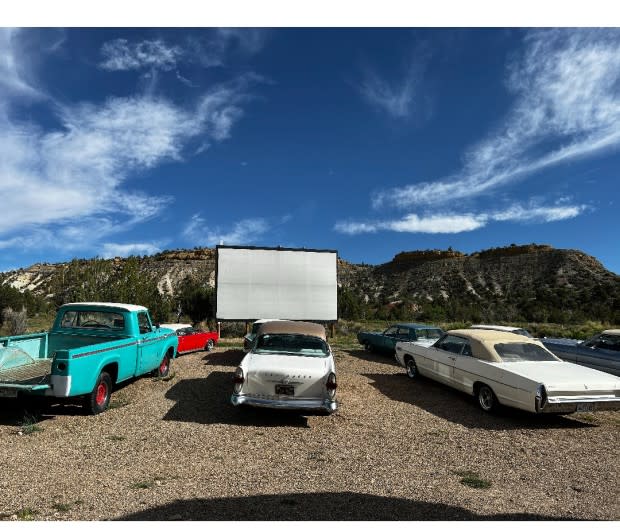
David Young
After a soak in the hot tub, we dine that evening on tasty cheeseburgers and ice cream from the food truck. Then a beer or two by the fire before slipping into a vintage blue truck with some popcorn to enjoy tonight’s movie, Willy Wonka.
All too soon, it’s time to pile back into the Sprinter van and head home. Our journey east passes through Capitol Reef National Park, where massive rock formations inspire more marveling—and consensus that this stellar road trip will definitely be getting a sequel.
